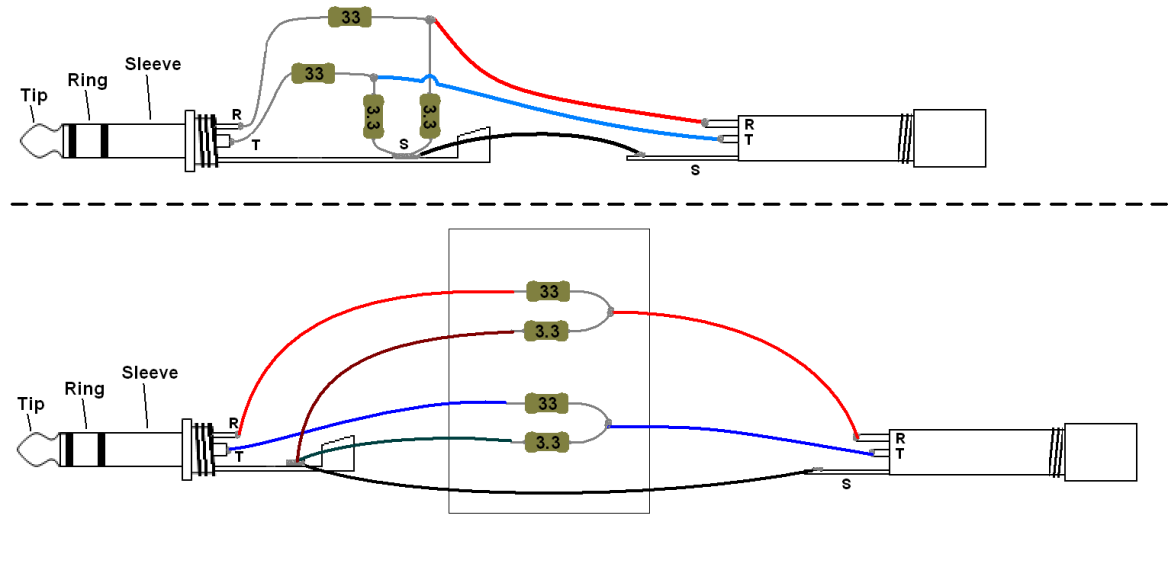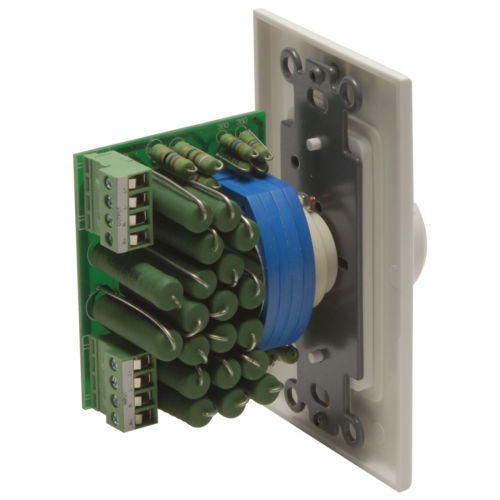YES! For once I "guessed" something right! I have some experience in passive crossover design and build for custom speakers of all types. I recognized the "L-pad" early in my research, but only seen it called out by that name a handful of times in the few threads I am still reading. I hate to crosspost, but you seem like you might be able to help me some. And I am itching to buy a bunch of resistors and parts to add to my “pile”. How important is matching the resistors? I will be ordering in bulk anyway, doesnt everyone LOVE sitting around with a DMM and a pile of resistors trying to pair or quad a set of
exactly matching resistors??? I will probably do it regardless... 'cause of my pseudo-OCD self. Lol....
I have noticed some people are inserting a third resistor, essentially creating a "center tap" from two resistors in series(instead of the one in parallel across pos and neg), and then running the "series" resistor from that "center tap" where the first two resistors connect to each other. Does this have any benefit you could think of? I'm a bit confused about this, it seems as if they might be able to better control impedance matching. They usually halve the impedance of the parallel for the two, but I thought that staggering it might have some effect, desired or not as long as they added up to the original value of the single parallel resistor. I realize that this puts the series resistor "behind" the parallel though. Any thoughts? I just found it curious.
I was also wondering about using a stereo stepped attenuator for different headphones. I have 80 Ohm for now, but plan on 600Ohm in the future, plus the flexibility to play ANY headphone is nice. I am going to build a Headphone switcher out of a Parasound 1U/"half rack width" speaker selector(once I make sure it is balanced and not common ground, or MAKE it balanced as it is just a passive switch), and an "empty" Parasound Zamp case(same dimensions as speaker selector, and I can “link” them into a “full rack width” 1U unit) to hold both front and back panel inputs and outputs. Obviously everything will be "balanced", and I hope to have a digital display(for each resistor) indicating what impedance is being introduced into the audio circuit, both to attenuate and to match impedance. Do you think that is possible, any suggestions? I am not completely helpless with a soldering iron, but far from a circuit design guru, but I think I already know of a circuit I can use to display the values....ironically it uses different value resistors to change numbers(old school "alarm clock" like LED), just for basic functionality. I am worried that the readings would be skewed by being “in circuit”. So I even thought of using a “bank” of reference resistors to display the value that is being used in the circuit.
I figured if anything I could build a box like that and use it to easily and quickly get the right value components and then switch it out with "hard wired" replacements; much like I use active crossovers to determine the best roll off frequencies, and then go back and fine tune with passive components.
So Mr. robrob, if you are still reading....What are you resistor value suggestions for the following amps? I plan to use an LPad regardless, and was going to use my Beyer 80ohm cans for now and will modify the cord to run true balanced with 4pin mini xlr, but like I said...will jump on the next set of high impedance cans I can find. Even just the drivers would work...I have a few pair of junk headphones that I would love to mod. People are less likely to steal what looks like a cheap pair of "no name" headphones.
Anyway, here is my “other post”....really dont know if I should post a link or the whole thing, but to make things easier on the “reader” I will just post the whole thing....
Basically, I have GAS(Gear Acquisition Syndrome)....sadly no dedicated headphone amps. Just a few pre and int. amps with "ok" sounding HP outs. Right now I have some stock Beyerdynamic Dt770/80, though I plan to get the 250 ohm version as well for doing mods. I do have several home amplifiers that I wouldnt mind trying. I have read about the parallel and series resistors and suggested values. Strange I always called that resistor configuration an L-pad and used it as a standard part of passive crossover design for speakers. Usually one was a variable resistor to adjust the attenuation. Now I realize that the resistors are more about impedance matching, but couldnt we use vari resistors to fine tune an amp to a pair of head pho9to figure out the right valuesnes? I am picturing a neat little case with a couple of knobs and some sort of digital readout of what values are currently being used. At the very least use the device to setup level for hard wiring; much like using active crossovers to determined the best crossover point to build in passive in speaker building.
Am I asking too much, is there already a product like this out there? If so, I cant afford it and still want to build one myself.
Some amps I am considering. The specs I think I need for the 80 Ohm cans (16 Ohm/20W “parallel”, and a 550 Ohm/ 0.25W “series”) What do you think of the higher impedance for the parallel(most have called for 8 ohms/10W, I have always thought that higher impedance speakers sounded better, and this would get the amp a bit further into its “sweet spot” if I understand this all correctly. Finally on resistors...do you really think there is much sonic difference between the “cheap” and the “megabuck”? Including my “matching” of resistors, I figured that the mid priced parts should do alright.
Amp 1 Conrad-Johnson MV-50 tube
Amp 2 Crown PSA2 SS (actually have two...talk about silliness

, but would just use one...for a while...lol then I would HAVE to try both) If I pop my cans its a good excuse to get the 600ohms....

(actually I would cry...I have big plans for the modest BD-DT770.
Amp 3 Parasound 855a SS five channel but I will only use two.
Amp 4 Crown D-150(I can hear the cringing from here...lol) VERY “SS” ssssssounding...lol, but certainly a powerhouse...
Amp 5. Some sort of Chip amp like the lm3887(or whatever it is, cant remember off hand)....SS, and I would still need to build it...lol
AMP 6 Even more out there...I have some VERY NICE car audio amplifiers, as well as a very powerful 12v supply (70A) that I use on my test bench for repairs and what not. In the past I used it to drive a pair of Soundstream 10.0 "Class A" amps to a pair of Magnepan MgIIbs. Sounded pretty good, also used some Denon car amps...and a slew of others(classics from the 1990's)... Some of the high current amps have me curious. The "cheater" amps rated at 50watts at 4 ohms, but would do 800watts if the impedance was driven low enough..usually 1ohm stable, 1/4ohm if actively cooled. More silliness I know, just would like to get some ideas before I start liquidating the majority of my collection.....car, home, HT, and pro sound(mostly amps and speakers).....baaaad gas. I know that a car amp seems silly but it could be battery powered, and some really do sound good, especially in the first watt, where I expect my headphones to stay. I have other "outlets" for LOUD.....

.
FWIW I also have Parasound Speaker Switch that I plan to incorporate, eventually. My custom speaker build has been put on hold.
Thanks for any productive replies, your time is very much appreciated. Obviously most concerned about the MV-50 tube amp, and was hoping someone had already successfully done one. I am under the impression that the both the parallel and the series need to be used for tube amps. It is el34 based, pretty sure common ground but will check when I unbox it...guess I could look at the schematics...heh. But pretty sure it will be fine, I was thinking of going a little higher that 10 ohms, maybe 16 or so, depending on what is available. Not really sure what to use for the "series" leg resistor though. Help!?!
Thanks again robrob, and anyone else who can help me out here. Nathan




 , but would just use one...for a while...lol then I would HAVE to try both) If I pop my cans its a good excuse to get the 600ohms....
, but would just use one...for a while...lol then I would HAVE to try both) If I pop my cans its a good excuse to get the 600ohms.... (actually I would cry...I have big plans for the modest BD-DT770.
(actually I would cry...I have big plans for the modest BD-DT770.



